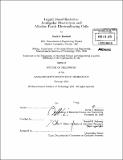| dc.contributor.advisor | Donald R. Sadoway. | en_US |
| dc.contributor.author | Bradwell, David (David Johnathon) | en_US |
| dc.contributor.other | Massachusetts Institute of Technology. Dept. of Materials Science and Engineering. | en_US |
| dc.date.accessioned | 2011-05-09T15:28:32Z | |
| dc.date.available | 2011-05-09T15:28:32Z | |
| dc.date.copyright | 2011 | en_US |
| dc.date.issued | 2011 | en_US |
| dc.identifier.uri | http://hdl.handle.net/1721.1/62741 | |
| dc.description | Thesis (Ph. D.)--Massachusetts Institute of Technology, Dept. of Materials Science and Engineering, 2011. | en_US |
| dc.description | Cataloged from PDF version of thesis. | en_US |
| dc.description | Includes bibliographical references (p. 198-206). | en_US |
| dc.description.abstract | Three novel forms of liquid metal batteries were conceived, studied, and operated, and their suitability for grid-scale energy storage applications was evaluated. A ZnlITe ambipolar electrolysis cell comprising ZnTe dissolved in molten ZnCl 2 at 500 0C was first investigated by two- and three-electrode electrochemical analysis techniques. The electrochemical behavior of the melt, thermodynamic properties, and kinetic properties were evaluated. A single cell battery was constructed, demonstrating for the first time the simultaneous extraction of two different liquid metals onto electrodes of opposite polarity. Although a low open circuit voltage and high material costs make this approach unsuitable for the intended application, it was found that this electrochemical phenomenon could be utilized in a new recycling process for bimetallic semiconductors. A second type of liquid metal battery was investigated that utilized the potential difference generated by metal alloys of different compositions. MgjlSb cells of this nature were operated at 700 °C, demonstrating that liquid Sb can serve as a positive electrode. Ca,MgIIBi cells also of this nature were studied and a Ca,Mg liquid alloy was successfully used as the negative electrode, permitting the use of Ca as the electroactive species. Thermodynamic and battery performance results suggest that Ca,MgIISb cells have the potential to achieve a sufficient cell voltage, utilize earth abundant materials, and meet the demanding cost and cycle-life requirements for use in grid-scale energy storage applications. | en_US |
| dc.description.statementofresponsibility | by David J. Bradwell. | en_US |
| dc.format.extent | 206 p. | en_US |
| dc.language.iso | eng | en_US |
| dc.publisher | Massachusetts Institute of Technology | en_US |
| dc.rights | M.I.T. theses are protected by
copyright. They may be viewed from this source for any purpose, but
reproduction or distribution in any format is prohibited without written
permission. See provided URL for inquiries about permission. | en_US |
| dc.rights.uri | http://dspace.mit.edu/handle/1721.1/7582 | en_US |
| dc.subject | Materials Science and Engineering. | en_US |
| dc.title | Liquid metal batteries : ambipolar electrolysis and alkaline earth electroalloying cells | en_US |
| dc.title.alternative | Ambipolar electrolysis and alkaline earth electroalloying cells | en_US |
| dc.type | Thesis | en_US |
| dc.description.degree | Ph.D. | en_US |
| dc.contributor.department | Massachusetts Institute of Technology. Department of Materials Science and Engineering | |
| dc.identifier.oclc | 717486146 | en_US |
